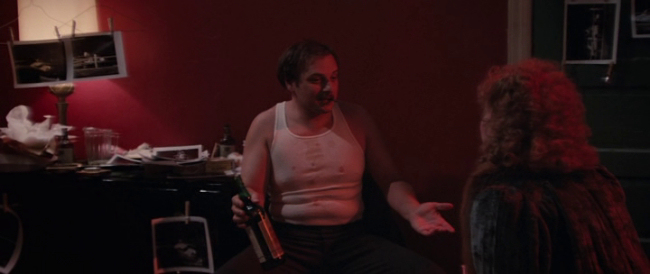
In 1981 Brian De Palma released his cocktail of Hitchcock and Antonioni to unenthusiastic audiences, a movie called Blow Out. Taking the basic premise from Antonioni's Blowup and throwing in quite a few Hitchcock references, particularly to Vertigo, De Palma never reaches the heights of his influences, in craft or storytelling depth, but stars John Travolta and Nancy Allen are charming and there's something entrancing about the film's broad cheesiness.

The best example of which is Dennis Franz as someone cut right of a pulp comic; a fleshy guy named Manny Karp in a food stained wife-beater drinking J&B from the bottle in a hotel room bathed in red light. Gavin Elster he ain't. But the scene, where he and Nancy Allen's character, Sally, talk about their scheme to frame a politician is a clear reworking of a few scenes in Vertigo. De Palma switches the green light from an outside sign to red as Truffaut did in his own Vertigo homage, Mississippi Mermaid, and it's in the hotel room we learn that the female lead has been misleading the male protagonist.

And as with Scottie and Elster, there's a connexion between Jack (Travolta) and Manny; they're both in the film industry and both seek to control and take responsibility for the female lead. There's no line about how saving someone's life makes you responsible for them but Jack does believe he saves Sally from drowning. But unlike in Vertigo, Sally isn't secretly in control of this moment and generally she's a much simpler character than Judy/Madeleine (or Catherine Deneuve's character in Mississipi Mermaid). Sally just seems like a sweet hustler who got mixed up in all this. We don't really get scenes from her perspective as we do with Judy so there's none of the emotional high stakes act of manipulation, part of what makes the last third of Vertigo so captivating.

The plot about a politician being assassinated is essentially just mechanics here, business, and lacks the deeper commentary on how art and public deception are related that we see in Blowup.

What is intriguing is De Palma's interest in showing how multiple stories occur simultaneously and the tension inherent in the potential for any two stories to connect with explosive consequences. Even the exploitation movie we see Jack working on at the beginning of the film is a nice collage of occurrences with the killer's POV outside the sorority, seeing the girls aimlessly partying in one room, and another girl frustrated in her attempts to study in another. Each of these three partially quarantined environments are separated as much by lighting as by physical barriers, creating the sense of different, isolated universes.

The fact that this film is a story within a story adds another layer and this storytelling technique is carried on throughout the film and we can see it in how Jack's impression of a story through sound eventually must be connected through Manny's story through imagery.

Like Scottie in Vertigo, Jack has a memory from his past working with the police in which something he did led to a cop's death, in this case his passion for sound design. He gets his second chance when he endeavours to save Sally with the use of a wire microphone she's wearing but this all lacks the psychological implications of Scottie's fear of heights. It becomes more of an interesting ode to film than a film with a story to tell in its own right.

No comments:
Post a Comment